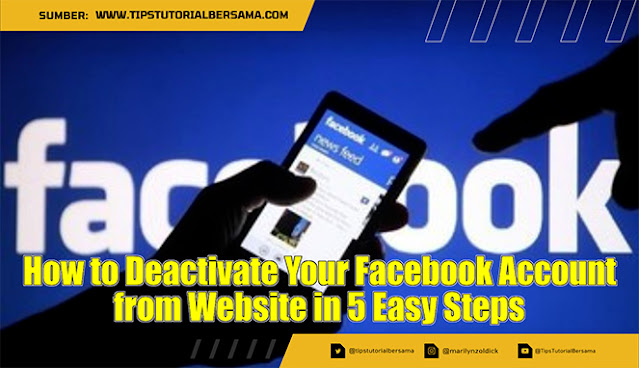In today's interconnected world, where social media plays a significant role in our lives, it's essential to have control over our online presence. If you're considering taking a break from Facebook and want to deactivate your account directly from your website, you've come to the right place. This step-by-step guide will walk you through the process of deactivating your Facebook account seamlessly and efficiently
Deactivating your Facebook account from your website offers several advantages. Firstly, it allows you to maintain privacy by disconnecting from the social media giant and preventing further data collection. Secondly, it helps in curbing the distractions and time-consuming nature of Facebook, enabling you to focus on other aspects of your life or business. Moreover, deactivation offers a temporary respite from the virtual world, allowing you to reevaluate your relationship with social media.
Throughout this article, we'll provide clear and concise steps to help you navigate the deactivation process effortlessly. From preparing your website for the change to disconnecting Facebook integration and notifying your users, we've got you covered. Additionally, we'll address any potential issues you may encounter and offer troubleshooting tips to make the process as seamless as possible.
Understanding the Importance of Deactivating Facebook
Before embarking on the process of deactivating your Facebook account from your website, it's crucial to comprehend the multitude of benefits that come with this decision. By deactivating your Facebook account, you gain greater control over your online privacy and take a much-needed break from the constant virtual noise.
One of the primary advantages of deactivation is protecting your personal information. Facebook is notorious for its data collection practices, and by disconnecting from the platform, you limit the amount of personal data shared with the social media giant. This step helps safeguard your privacy and reduce the risk of unauthorized access to your information.
Moreover, deactivating Facebook allows you to break free from the addictive nature of social media. It gives you an opportunity to refocus your time and energy on more meaningful activities, whether it's spending quality time with loved ones, pursuing personal hobbies, or enhancing productivity in your professional life.
| Read Also : How to File Tax Extension: A Step-by-Step Guide |
Preparing Your Website for Deactivating Facebook
Before diving into the process of deactivating your Facebook account from your website, it's crucial to ensure that your website is adequately prepared for this change. Taking a few essential steps beforehand will help minimize any potential disruptions and keep your users well-informed.
Firstly, it's important to back up any data or content that is directly linked to your Facebook integration. This ensures that you have copies of any information that might be affected by the deactivation, such as user comments, social sharing statistics, or other relevant data.
Next, it's crucial to notify your website users about the upcoming deactivation of Facebook integration. Transparent communication is key to maintaining trust and minimizing confusion. Clearly explain the reasons for the deactivation, emphasize the benefits, and provide alternative ways for users to stay connected or engage with your website.
Step-by-Step Guide to Deactivating Facebook from Website Facebook
To successfully deactivate your Facebook account from your website, follow these step-by-step instructions:
- The first step that must be done first is to visit the Facebook.com page through a browser.
- Then click the profile photo, then select Settings & Privacy.
- Then click Settings.
- Next select Privacy >> Your Facebook Information.
- Next, on the right side of the screen, click Deactivation and Removal.
- Then select the Deactivate Account option, then click Proceed to account deactivation.
- Next enter your Facebook password and deactivate your account.
- Done.
Additional Considerations and Troubleshooting
While deactivating Facebook from your website is a straightforward process, it's essential to consider a few additional factors and be prepared for any potential issues. Here are some key points to keep in mind:
- User Impact: Anticipate how the deactivation might affect your website users. Address any concerns or questions they may have and provide clear instructions on how to navigate the changes.
- Alternative Social Media Integration: If you previously relied heavily on Facebook for social sharing or user login, consider implementing alternative social media integration options. Explore other platforms that align with your website's goals and user preferences.
- Testing Across Devices: Ensure that you thoroughly test the deactivation across different devices and browsers. Verify that the Facebook features are effectively disabled and there are no unexpected errors or display issues.
- Regular Monitoring: Keep an eye on user feedback, website analytics, and any potential issues that may arise after the deactivation. Address them promptly to maintain a smooth user experience.
- Stay Updated: Stay informed about any changes or updates from Facebook that may impact the deactivation process. Periodically review your website settings and make necessary adjustments to ensure continued functionality.
In case you encounter any troubleshooting challenges during the deactivation process, consult Facebook's developer documentation or seek assistance from online communities or forums. By considering these additional aspects and troubleshooting effectively, you can successfully navigate the deactivation of Facebook from your website and provide a seamless experience for your users.
Conclusion
Congratulations! You have successfully completed the process of deactivating your Facebook account from your website. By following the step-by-step guide and considering the important aspects, you have taken control over your online presence and created a healthier digital environment. Remember to keep your website users informed about the changes and provide alternative ways for them to stay connected.
Embrace the benefits of this deactivation, such as enhanced privacy,
reduced distractions, and the opportunity for self-reflection. Enjoy your
newfound freedom from Facebook and explore new avenues to engage with your
audience. Embrace a balanced approach to your online presence and make the
most of your website's potential.










